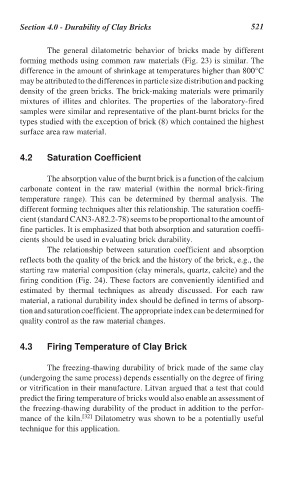Page 551 - Handbook of Thermal Analysis of Construction Materials
P. 551
Section 4.0 - Durability of Clay Bricks 521
The general dilatometric behavior of bricks made by different
forming methods using common raw materials (Fig. 23) is similar. The
difference in the amount of shrinkage at temperatures higher than 800°C
may be attributed to the differences in particle size distribution and packing
density of the green bricks. The brick-making materials were primarily
mixtures of illites and chlorites. The properties of the laboratory-fired
samples were similar and representative of the plant-burnt bricks for the
types studied with the exception of brick (8) which contained the highest
surface area raw material.
4.2 Saturation Coefficient
The absorption value of the burnt brick is a function of the calcium
carbonate content in the raw material (within the normal brick-firing
temperature range). This can be determined by thermal analysis. The
different forming techniques alter this relationship. The saturation coeffi-
cient (standard CAN3-A82.2-78) seems to be proportional to the amount of
fine particles. It is emphasized that both absorption and saturation coeffi-
cients should be used in evaluating brick durability.
The relationship between saturation coefficient and absorption
reflects both the quality of the brick and the history of the brick, e.g., the
starting raw material composition (clay minerals, quartz, calcite) and the
firing condition (Fig. 24). These factors are conveniently identified and
estimated by thermal techniques as already discussed. For each raw
material, a rational durability index should be defined in terms of absorp-
tion and saturation coefficient. The appropriate index can be determined for
quality control as the raw material changes.
4.3 Firing Temperature of Clay Brick
The freezing-thawing durability of brick made of the same clay
(undergoing the same process) depends essentially on the degree of firing
or vitrification in their manufacture. Litvan argued that a test that could
predict the firing temperature of bricks would also enable an assessment of
the freezing-thawing durability of the product in addition to the perfor-
mance of the kiln. [32] Dilatometry was shown to be a potentially useful
technique for this application.

